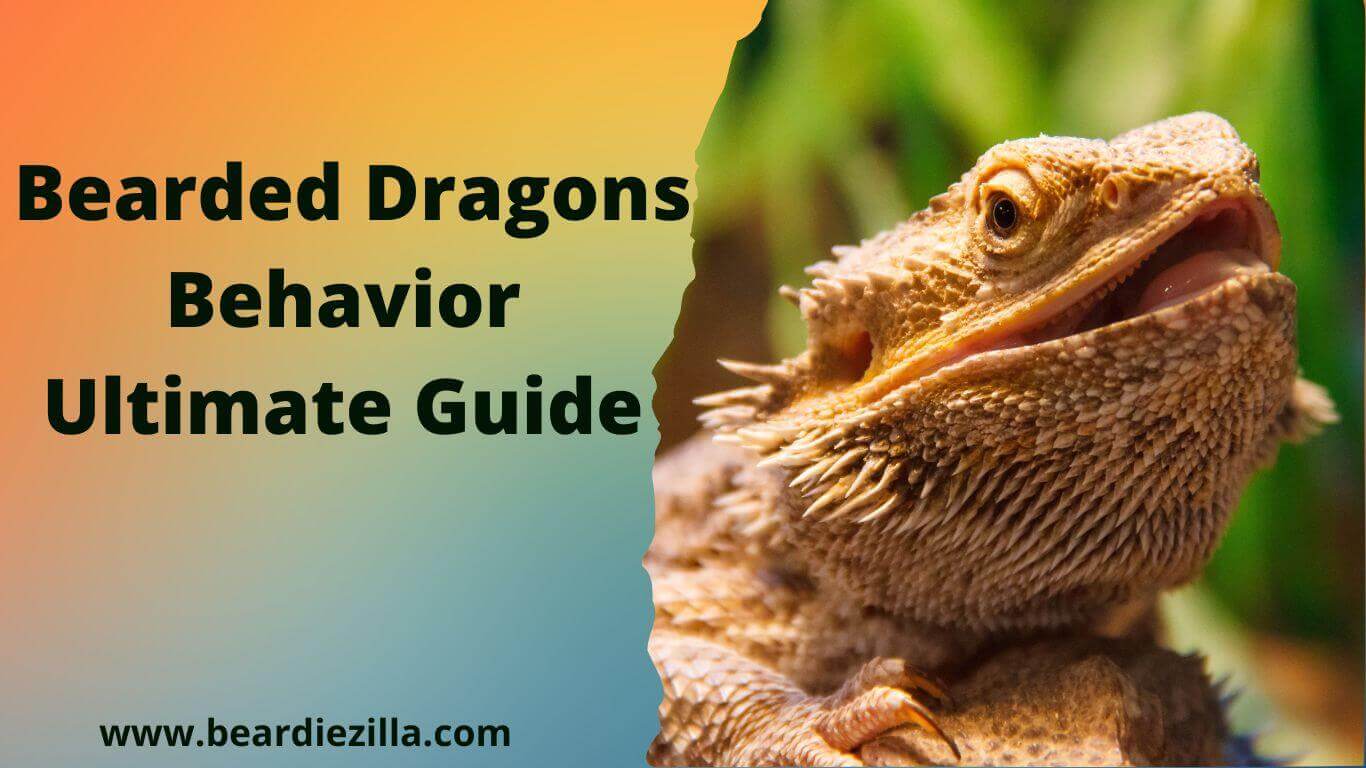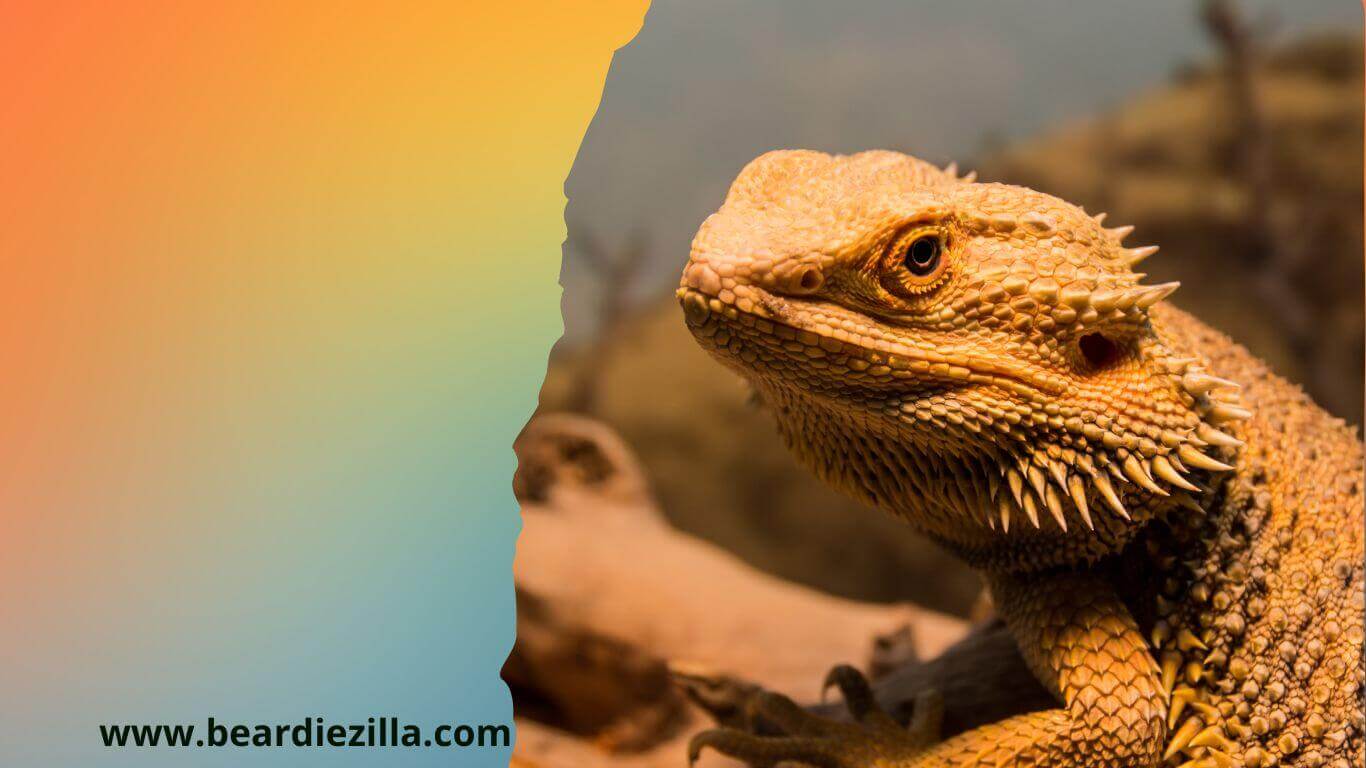
Many owners have already noticed it by observing their pets. The body language of bearded dragons is very clear compared to humans. It is still versatile. This is what prompted us to write this extensive article.
In the following you will learn how to interpret the behavior of your bearded dragons. Thus, discover how to respond to their needs. They have a large repertoire of signals that make it easy for us owners to understand their behavior. Still, you need to learn a few basics to understand their body language.
Bearded Dragons Behavior Basics
Bearded dragons have very good eyesight and can spot other creatures from a great distance. That’s why they love to sit in elevated positions and watch what’s going on around them.
If you want to better understand the behavior of your bearded dragon, you should focus on their body language. The ability to emit sounds is not particularly well developed in the small dragons. Only a hissing or humming can be heard from time to time when they fend off an attacker.
Unfortunately, the face is also not very revealing. It’s so rigid that you can’t see any play of facial expressions. Nevertheless, as an experienced owner, it is not that difficult to understand the behavior correctly and to respond to the needs of your pet.
Exploratory Behavior
Bearded dragons usually use their tongues to explore their surroundings. This way they can check objects, food or conspecifics for their olfactory information. In order for this to work, the things to be examined are licked off. In technical jargon one speaks of tongues.
The traces of smell and pheromones now on the tongue are passed on to Jacobson’s organ when it is pulled back. This now processes the information and passes it on to the brain via nerve stimuli.
However, the tongue does not only serve to absorb odor traces. Bearded dragons often use this behavior as a form of greeting. It is easy to recognize by the fact that they lick each other’s neck areas.
Are You Concerned About A Certain Behavior?
Bearded dragons often do something specific and you just don’t know why. Our table with the most common behavior patterns and their meaning will help here. Therefore, you do not have to read the whole guide.
| Behavior | Meaning | Comment |
| Head noding | Gesture of dominance | Executed by the higher tier towards the lower tier. |
| Raising the front half of the body. Often accompanied by tail flicking and beard spreading. | Gesture of dominance | This demonstrates a high claim to rank. |
| Waving / twisting arms | Gesture of appeasement | Executed by the inferior bearded dragon in the direction of the higher-ranking animal. |
| Ducking | Gesture of humility | Designed to prevent an opponent from attacking you |
| Crouching with tail lift and neck bite | Mating behavior | reproduction |
| Opening the mouth including spreading and coloring the beard black. | Threatening gesture | Defense against enemies or attackers. |
Thermoregulation

As with all other reptiles, bearded dragons are so-called poikilothermic animals. This is another term for cold-blooded animals. Their body temperature is influenced by the environment.
Therefore, you have to set up sunbathing areas in every terrarium to warm them up. But don’t forget the cooler areas. Bearded dragons increase their body temperature by increasing body surface area. This can usually be recognized by the fact that they widen and their body flattens out.
Furthermore, the coloring of their bodies changes throughout the day. This is due to the contraction of the melanin-containing skin cells. This is noticeable because the animals are darker in the morning than in the evening. Once they have warmed up long enough to bring their body temperature between 30 and 40 degrees Celsius, they will begin to become more active and eventually eat.
So that they do not overheat, the skin is lightened and shady places in the terrarium are sought out. If they can’t get their temperature down enough, they start panting. This results in evaporated fluid that cools the lining of the mouth. It also lowers body temperature. The behavior of bearded dragons in thermoregulation is exciting to watch. At least for beginners.
Good To Know: Bearded dragons in the wild do not want to cool down too quickly at the end of the day. Therefore, you can often find them in the evenings on asphalt roads or stones that are still nice and warm.
Defense Behaviors
Bearded dragons close their eyes as a defensive gesture. Unfortunately, this is often misunderstood. Closed eyes are often misinterpreted as an expression of relaxation when being petted. However, this is clearly a behavior of bearded dragons that should be understood as a gesture of rejection. The stroking has to be stopped.
There are, of course, much clearer signals that bearded dragons use as a defensive mechanism. When they want to threaten, they raise their beards and open their mouths as wide as possible. If this behavior is still not clear enough, the hissing begins. The bearded dragon now wants to scare the enemy away.
Very often they spread their beard and show off many spikes. Furthermore, they flatten their body. And only in exceptional cases does an attack occur.
Dominance Behavior
There is also a social hierarchy in bearded dragons. The experienced observer recognizes this quickly. In this case, higher-ranking animals compete for food with those of lower rank. Furthermore, the highest-ranking bearded dragon has the most beautiful vantage point and sunbathing spot.
A dominant beardie will have jerky head nods. This is usually answered by the other animals with a soothing wave. If a bearded dragon wants to demonstrate its claim to rank as clearly as possible, the beard is often spread out as much as possible and colored. In addition to that, some nod and slap their tails.
Good To Know: The coloring of bearded dragons provides information about how the animals are feeling at the moment. For example, the body color varies with fear, aggression or well-being. If you observe your animals carefully, the coloring will give you a lot of information about how the bearded dragon is feeling over time.
Humble Behavior
Not only waving or twirling your arms is a classic gesture of humility for bearded dragons. As a sign of appeasement, inferior animals often lie down as flat as possible on the ground. Such a gesture of submission is often seen in response to the nod from the senior animal.
A slightly weaker form of this is crouching the body and slowly moving the head and upper body up and down. From time to time this behavior can also be observed in bearded dragons towards the owner.
Fights

As a good keeper you should know how to prevent fights between your bearded dragons as much as possible. Eventually, the animals can lose toes, legs or the tip of their tail. If there is a fight, it usually starts with both opponents circling each other and then approaching each other from the side.
If none of the bearded dragons then executes calming signals such as waving, then it’s off to a good start. The aim is to bite the opponent into the side spiked scales. If this worked, the superior animal tries to push itself over the weaker one. This procedure is very reminiscent of mating.
Most of the time, the defeated bearded dragon remains motionless on the ground until it can finally flee. In the wild, this is absolutely normal and not a problem. On the other hand, if the bearded dragons are kept in a terrarium, this is not so good.
After all, the area is very small and retreat is only possible to a limited extent. As a keeper, you usually have to intervene and separate the animals from each other in the long term. Otherwise it can happen that the inferior bearded dragon eats less and less due to fear and the associated permanent stress. Sometimes it is even eaten by the superior animal.
Inferior males often adopt the behavior of females in order to continue to appease the superior. We therefore advise against keeping 2 males in one terrarium. Some owners even report that the gender determination of such a bearded dragon is no longer clear. Of course, such behavior in bearded dragons is not the goal of keeping them.
Courtship
Bearded dragons do not just nod to demonstrate dominance. The multiple nods also represent the beginning of the courtship behavior. In addition, the beard is colored dark to make it clear to the female that one is ready for mating.
The nod is usually returned in the form of arm movements. Otherwise, the female stays calmly in place. Sometimes the tail is also raised slightly. As soon as the male has carried out his mating bite in the area of the side of the neck or in the neck, the actual mating can already take place.
But sometimes the female is not in the mood to be mounted. Then the male tries to shake it off in the truest sense of the word. She often resorts to bites and slaps with her tail.
Females can therefore become very aggressive. They don’t shy away from attacking their owner if he tries to end the fight. Despite the possibility of being injured, it is better to separate the animals. After a while they act like nothing happened.
FAQ
This topic seems to intrigue our readers. From time to time we get really interesting questions about the behavior of bearded dragons by mail. We have listed the most interesting of them. You, too, and not just the person asking the question, benefit from our answers.
Bearded Dragon Behavior During Shedding?
It usually all starts with the skin becoming increasingly cloudy and milky. Eventually, the animals begin to scratch themselves or even rub against objects in the terrarium. It can take several days for the molt to be complete. If you want to help the bearded dragon with this, you can bathe it in lukewarm water.
Why is my bearded dragon constantly scratching the glass?
This behavior can be explained very easily. The little bearded dragons do not understand that the transparent pane does not allow any passage. Even after a few years, they still show this behavior pattern. If you really want to prevent this, you can paint the lower part of the panes, for example.
Does bearded dragon behavior change with age?
Yes. The animals become more and more inactive and even stop their mating activities. They are also often more susceptible to stress and illness. In addition, some older bearded dragons hardly ever climb and many older animals are no longer seen as leaders of the group. Solitary confinement is often appropriate.
